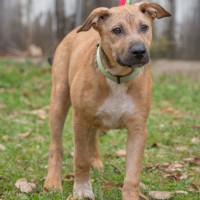Appearance of the Bullmasador
|
| These dogs, which can be found in red, fawn, brindle, light brown or black with white and chocolate markings, have a dense, glossy, short coat. Their fur is also water-repellent and can have several markings, including tuxedo, tricolor, brindle or simply solid color. Their fur is water-repellent and double-layered, but sheds very little. They have floppy, downward-pointing ears and fearless eyes. These very large dogs measure around 58 to 74 centimeters and between 32 and 82 kilos will be a healthy weight for these dogs. They have muscular bodies and thick necks that are very strong. Their faces will be smooth and their tails long. These dogs can also take on certain characteristics of the Bullmastiff and Labrador Retriever. To find out more about the appearance of this breed, search for the appearance of the two parent breeds. |
Temperament of the Bullmasador
|
| These dogs will have the intelligent, calm temperaments of a Labrador Retriever with the size and strength of a Bullmastiff. They are big, strong dogs, loyal and undeniably faithful to their owners. They are also gentle and protective of children, making them excellent pets. This breed loves to please its owners and, because of its high intelligence, will be easy to train. However, they are very large and can be a handful for an owner who has no experience with dogs. To train and socialize this breed, you need to be consistent, patient and sure to reward them for good behavior. They are devoted to their families and will make great watchdogs who will alert you at the first sign of something unusual. With good socialization, these dogs are likely to be good with other pets too. |
Needs and activities of the Bullmasador
|
| This designer breed is very active and will need a large yard for exercise. However, don't overwork them or keep them outside in the heat for too long, as they can easily develop heatstroke. The Bullmastiff generally needs 30 to 45 minutes of daily activity, and the Labrador Retriever does well with about an hour's exercise, so we can conclude that the Bullmasador will need around 30 to 60 minutes of activity a day. |
Maintenance of the Bullmasador
|
| The Bullmasador is a light shedder with a coat that's easy to care for. Apart from needing an occasional bath perhaps once a week, as well as brushing twice a week, this breed is fairly easy to care for. All breeds should have their ears cleaned weekly, but especially Bullmasadors, as they are prone to ear infections. Don't let them stay outside too long in very hot weather, as these big dogs are prone to heat stroke. Some people choose to buy kiddie pools for their Bullmasadors to keep them cool during the hot summer months. All dogs need to have their teeth and nails groomed. Brush your dog's teeth every day. Your pet should also have its nails trimmed once or twice a month. However, some dogs will need to have their nails trimmed less often if they are active and wear them down naturally. If you hear your Bullmasador's nails clicking on the ground when they walk, the nails are definitely too long and need to be trimmed. |










 English (United Kingdom)
English (United Kingdom)